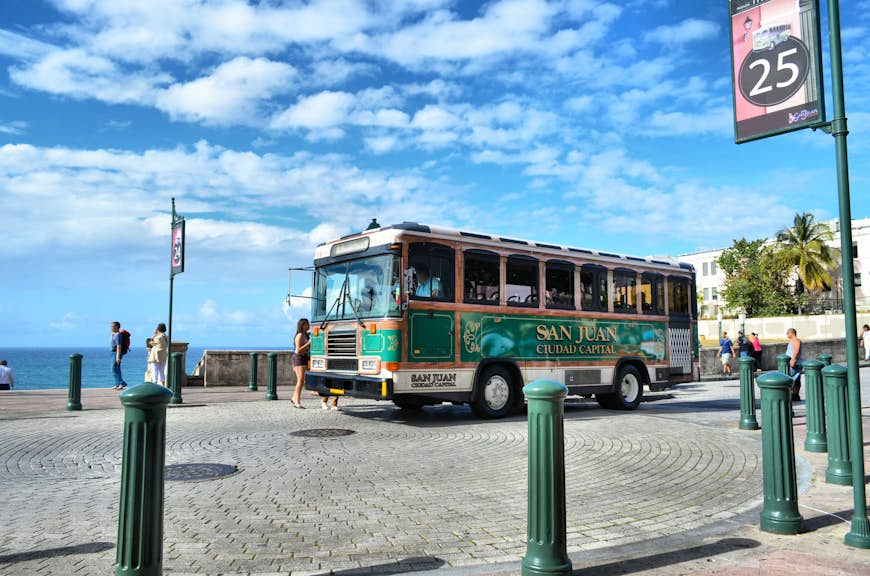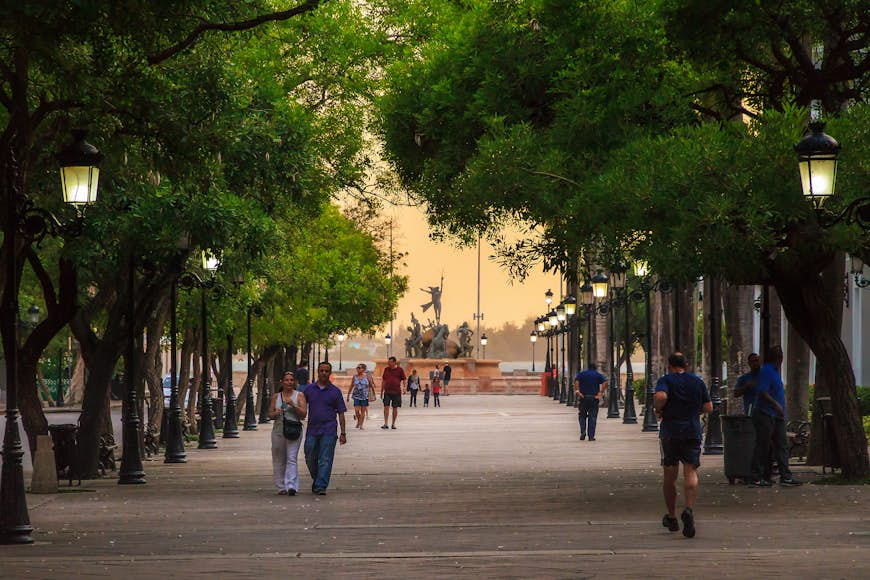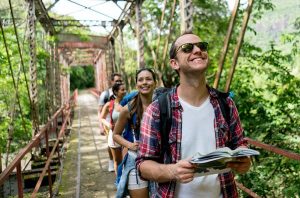
Congestion is a part of life in Puerto Rico, where everyone and their grandmother owns a car, and driving is the predominant mode of transportation. This is also due to Puerto Rico being a large island, the dearth of public transportation and numerous far-flung destinations.
That said, it’s perfectly possible to navigate the capital of San Juan by bus, metro, taxi and on foot. As for the rest of the island, here are the best ways to get around.
Make the most out of every adventure with help from our weekly newsletter delivered to your inbox.  Service may be erratic but buses are a cheap way to get around Puerto Rico © Getty Images / iStockphoto
Service may be erratic but buses are a cheap way to get around Puerto Rico © Getty Images / iStockphoto
San Juan has a bus network and a metro system
San Juan is the only city in Puerto Rico that’s served by an extensive network of clean, air-conditioned city buses. However, route maps and information can be hard to find and few bus stops indicate which buses stop where. Service can also be erratic, with wait times between 30 and 60 minutes. Ask around at bus stops, where veteran riders will offer advice.
San Juan is the only city in Puerto Rico with an inexpensive, efficient metro. Trains run every 16 minutes daily between 5:30am and 11:30pm, connecting the popular neighborhood of Santurce with the university campus of Río Piedras and shopping centers in Hato Rey and Torrimar with far-flung Guaynabo and Bayamón.
Cycling on the road in Puerto Rico is an extreme sport
To put it bluntly, cycling across Puerto Rico is foolhardy at best, and tantamount to a death wish at worst. Cyclists have to contend with multiple hazards, from nightmare traffic and poor road conditions to dangerous drivers, and a general lack of awareness about cyclists’ needs. Cycling after dark is a major no-no.
…except in San Juan, where there are designated bike lanes
Recreational cycling is possible in San Juan, where there’s a pleasant and safe cross-city route along the shoreline from Old San Juan through Condado and Isla Verde as far as Piñones (the last part is on a designated bike lane). Rent a variety of well-maintained bikes, including mountain, road, electric, hybrid and cruisers from San Juan Bike Rentals – it’ll even deliver your wheels to your hotel.
Driving is the only option in some parts of Puerto Rico
Many of Puerto Rico’s roads are in poor shape, especially after being battered by recent hurricanes. Outside the well-maintained Expressway toll roads, bumps, potholes and broken guard rails are a fact of life, along with erratic driving, animals wandering out onto the road and more cars per square mile than any other place on earth.
Despite all that, having your own wheels is the most convenient way of getting around outside the capital, and downright essential if you want to roam the countryside, visit national parks, or explore the spectacular 167-mile Ruta Panorámica that runs along the mountainous spine of the island from Mayagüez to Cayey.
Car-rental rates in San Juan are very competitive; elsewhere, not so much. A car costing US$30 or less a day in San Juan will cost US$60 or more in smaller cities and on the islands. Some companies prohibit taking rentals from the mainland to Culebra and Vieques.
All of the major international car-rental companies operate on the island, especially at the airport in San Juan. There are also local firms, particularly in smaller cities and on the islands.
Local tip: If you’re limiting your trip to San Juan, a rental car is a liability; the traffic is terrible, and parking is scarce. Use public transportation and taxis instead. Parking is a real problem in central Ponce also.
Ferries head for some islands, otherwise hire a private boat
Frequent daily ferry services serve the islands of Vieques and Culebra, departing from Ceiba’s ferry terminal a 25-minute drive south of the port of Fajardo. Up-to-date ferry schedules and tickets are available online; arrive at the terminal at least an hour before the boat departs. In January, if you’re lucky, you can sometimes spot humpback whales from the ferry. Services can be delayed and/or cancelled altogether during hurricane season (early June to late November). There are no ferries between Vieques and Culebra.
There are also no ferries to tiny, uninhabited Isla Mona – an adventure destination for divers and wildlife lovers – off Puerto Rico’s west coast. The only way to get there is by private boat with accredited operators such as Acampa Nature Adventures or Adventures Tourmarine.
Internal flights are limited and usually not worth it
Daily domestic flights connect San Juan’s Luis Muñoz Marín airport with Mayagüez on the mainland’s west coast, and with the offshore islands of Culebra and Vieques off the east coast. However, given how it takes two hours to drive from San Juan to Mayagüez and an hour to drive from San Juan to Fajardo before taking a (much cheaper) ferry to Culebra or Vieques, there is little reason to fly.
 Exploring on foot isn’t possible everywhere in Puerto Rico but a stroll along the promenade in San Juan is always a pleasure © Getty Images / iStockphoto
Exploring on foot isn’t possible everywhere in Puerto Rico but a stroll along the promenade in San Juan is always a pleasure © Getty Images / iStockphoto
Walking is a pleasure in the historic centers of San Juan and Ponce
Old San Juan and the historical center of Ponce are wonderfully walkable and a pleasure to explore on foot. The same cannot be said about the majority of Puerto Rico’s towns and cities, with their often nonexistent sidewalks and cookie-cutter urban sprawl.
Públicos are the cheapest way to travel the island
The cheapest way to get around Puerto Rico is by públicos – public minibuses that run prescribed routes during daylight hours, either between places such as San Juan and Ponce or Mayagüez, or short-haul. Públicos are vans with the destination clearly written in the front window, leaving once they’re full. Some are busiest with commuters in the early morning and evening, while others run to remote destinations and might leave you stranded due to their infrequency. Taking a público is a great local experience, provided you don’t mind being very hot and squeezed in with a million other passengers. There is no central source of info about schedules or prices; just turn up at a público terminal or van stand near a smaller town’s central plaza, and ask around.
Taxis and Uber are readily available in larger cities
Taxis are ubiquitous in San Juan and larger cities around the island. It’s often quicker to walk out to a taxi rank or flag down a passing taxi than get through to one on the phone. Meters are hardly ever used, so always agree on the price before setting off. The one exception is San Juan: “tourist taxis” are regulated by the Puerto Rico Tourism Company, and fixed rates are determined by the zone your destination falls into.
Uber is popular, inexpensive, and covers San Juan, much of the north coast (including Arecibo and Fajardo), as well as the eastern half of the island (Caguas, Fajardo) and part of the south coast (Guayama and around). It doesn’t cover Ponce, Cabo Rojo or Mayagüez. Within San Juan, taxi lobbying groups have pushed for legislation that prohibits Uber from picking up or dropping passengers off at the airport or at certain hotels.
Accessible transportation in Puerto Rico is improving
Travel is becoming easier for those with mobility issues thanks to the Americans with Disabilities Act (ADA). Public transportation services (such as San Juan’s public bus and metro, plus taxis) are now required by law to be wheelchair-accessible. On top of that, there are wheelchair-accessible shuttles from the airport, while Equipos Pro Impedidos Caguas offers wheelchair-accessible vehicle rentals.



